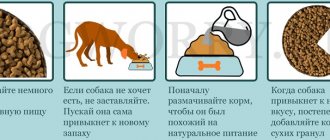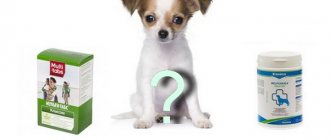Why combine dry and natural food?
Most owners note that it is much more convenient to feed the puppy store-bought food, the composition of which is calculated. At the same time, many of them express some distrust of its composition. Dry options, indeed, come in different qualities. The BJU ratio is important not only in the human diet, but also in the diet of a pet. However, calculating the correct percentage of protein will be quite difficult. It can be of two types - plant and animal. Many manufacturers do not indicate exactly what type of protein is contained in the granules.
Is it possible to mix the two options? Many breeders are interested in
In addition, the dry version may contain processed products, for example, it is much more profitable to add vegetable oil instead of animal protein, and meat flour instead of animal protein. All this makes production cheaper, but can affect the dog's health. In this case, the product will still be considered balanced, because the ratio of BJU is normal, but the animal’s body will not receive the necessary microelements.
You can mix dry food and natural food in some cases, for example:
- the animal does not have allergic reactions;
- the animal’s skin, fur, and stool are normal, which means its health status is not cause for concern;
- Only high-quality manufacturers are used;
- The main part of the diet is the dry version, and the natural product is only an additive.
For your information! It is necessary to clearly monitor the amount of food your pet consumes.
There are only a few cases when you can mix products
Why mixing different options can be harmful
Veterinarians highlight the pros and cons of mixed feeding for dogs. The main reason why such a diet can be harmful is the inability to track the balance of food. The owner is unlikely to be able to accurately track how much protein, fat and carbohydrates have entered the dog’s body. This is due to the fact that the composition of natural products in many reference books is averaged.
Is it possible to feed a cat both dry and wet food at the same time: examples of mixing
In addition, dry food may contain substances in concentrated form, and for this the owner will have to independently recalculate the elements. This may be the reason that some substances will be in excess, while others will be in short supply. Such an imbalance will lead to health problems in pets over a long period of time.
Note! When mixing different foods, it is difficult to determine the total caloric content of the diet. High calorie content for a dog can cause overweight in a dog.
Also, on a mixed diet, an animal may develop allergies or other digestive problems.
Of course, most dogs love natural food, because it smells better and has a much more physiological consistency, which is why there can be problems with a mixed diet.
Pros and cons of dry food
All of the listed advantages apply only to premium and higher class feeds. Pros:
+ visible composition The packaging of high-quality dry food always contains detailed information about the percentage of each ingredient, as well as the analytical composition and exact content of proteins, fats and carbohydrates.
+ time saving Dry food does not require additional preparation, and the daily intake is indicated on the package. + balanced diet Dry food contains the required proportions of proteins, fats and carbohydrates. The balance of nutrients, vitamins, minerals and trace elements does not require adjustment by additional feeding. High-quality food has a breed and age division, the composition of which fully meets the individual needs of dogs. + large selection and interchangeability The range of dry food is very diverse, so replacing one diet with another is easy and simple. The ability to quickly adjust the menu is especially important for dogs with sensitive digestion and allergies. + stress-free vacation When you go to another city, you can leave your pet with friends, family or in a hotel, without worrying about what they will feed it. The main thing, when giving your pet away, is not to forget to “attach” a sufficient amount of food to it, which will last until the owner returns. When traveling with your animal, you can easily take dry food with you. Cons:
- economy class food Store shelves are lined with mostly cheap economy class food.
Inexperienced dog breeders may succumb to advertising tricks and start feeding the dog low-quality products, which will negatively affect its health. — water This cannot be called a serious disadvantage, but it is always worth remembering that a dog eating dry food needs more drinking water.
Mixed feeding upsets the balance of dry food
Is it possible to feed a cat dog food - wet or dry and what is the difference?
Is it possible to alternate dry food and natural food for dogs? In this case, you can feed your dog both dry granules and natural products at the same time, but you should be aware of some points. With this type of nutrition, there may be an imbalance, which will lead to problems with the dog’s health. However, you should not think that all feeds have this balance correctly. Cheap option for dogs, just as balanced as Rollton for people. More expensive brands, of course, contain probiotics, but many components will still be in short supply. For example, a dog may lack fresh vegetables, fruits, herbs, sour milk, cottage cheese, as well as any easily digestible proteins, for example, quail eggs, turkey.
Important! It is best to give preference to premium food, as they rarely cause allergies or gastrointestinal diseases. And also, in most cases, they are suitable for all breeds.
The main fear of many breeders is an overabundance of vitamins. It is important to remember that, in addition to this, there are such concepts as digestibility and biocompatibility. An overabundance can only happen if you consume artificial vitamins and microelements. Natural ingredients will enter the body in the required quantity, and excess will be eliminated biologically. Many owners whose dogs are only on dry food notice some food perversions in their pets (grabbing and eating anything). In this case, it is necessary to add raw meat or black tripe to the diet.
Mixed food without harm to the dog's health
Natural nutrition
For 1 kg of dog weight you need 15-25 g of meat. Thus, an adult dog weighing 15 kg should receive 225-375 g of meat per day. The nutritional value of fish and meat is approximately the same; if meat is replaced by offal, then they should be given approximately one and a half times more.
An acceptable diet in percentage terms is as follows:
- 30-50% meat, offal or fish;
- 25-35% cereal;
- 20-30% fermented milk products;
- 10-15% vegetables and fruits.
However, ideally, the diet should contain more meat and dairy products:
- 50-70% meat, offal or fish;
- 30-40% fermented milk products;
- 10-20% vegetables and fruits;
- 10-15% coarse.
A little sunflower oil (1-2 drops per kilogram of weight) and fish oil are added to food daily, and raw or boiled eggs are fed 2-3 times a week. Vitamin and mineral supplements are given during the period of active growth and subsequently in the off-season. Puppies of large and giant breeds are also required to be fed chondroitin, glucosamine, calcium and fat-soluble vitamins for the normal development of the musculoskeletal system. During seasonal molting, complexes for skin and coat are recommended.
Natural nutrition - confidence in the quality of products
Meat (beef, poultry, rabbit) should contain some amount of cartilage, tendons, and fat. Lamb is too fatty for many dogs and causes digestive upset. Pork is not recommended to be fed raw due to its fat content and the likelihood of parasites, which are destroyed during heat treatment.
It is better to feed fish raw. When feeding only raw fish, hypovitaminosis B1 develops, but for a homemade mixed diet this problem is not relevant. Fish is given instead of meat 2-3 times a week. Fillet of sea or ocean fish is suitable; river fillet must be frozen or boiled, which will avoid infection with helminths.
Dairy products in the form of cottage cheese, yogurt, kefir, sour cream 10-15% fat. Most dogs cannot digest whole milk. You can add a little honey to dairy products and beat in an egg. From time to time it is useful to cook calcined cottage cheese for your dog. It is not necessary to give milk every day. However, on those days when it is absent, it is necessary to increase the amount of meat and offal. Dairy and meat products are not mixed in one feeding.
The grains are cooked in bone broth. Rice and buckwheat are best; sometimes you can give barley and oatmeal. You should not cook corn, pearl barley, or legume porridge, which are difficult to digest.
We invite you to familiarize yourself with: Feeding sheep at home: diets and standards || Features of feeding sheep
It is better to feed vegetables raw; suitable: carrots, cucumbers, white cabbage, peppers, zucchini, pumpkin, beets. If the vegetables are not easily eaten, you can lightly stew them. Be sure to add greens, and in summer also herbs (nettle, dandelion, knotweed).
Every owner should know what not to feed their dog:
- Exclusively meat and protein products - puts a lot of strain on the kidneys;
- Bones have no nutritional value and can lead to constipation and damage the gastrointestinal tract;
- Poor quality products can cause poisoning of varying severity;
- Sweets cause allergic reactions, burden the liver, provoke obesity and the development of diabetes;
- Fatty, fried foods burden the liver and pancreas;
- Salty food provokes salt deposits, joint problems, and electrolyte imbalance;
- Spicy food irritates the gastric mucosa, which can lead to gastritis and ulcers;
- Raw river fish and pork can be infected with helminths;
- Cat food high in protein and fat can lead to kidney failure;
- Legumes, products made from wheat flour and heavy cereals increase gas formation in the intestines, and in large breeds they can cause gastric volvulus.
Pros:
- Confidence that the dog is receiving quality products.
- Ability to independently adjust your diet.
Minuses:
- As a rule, it is more expensive than dry food and requires regular administration of vitamins and minerals
- The need to cook regularly and take up space in the refrigerator.
In what cases is mixed feeding of dogs acceptable?
Is it possible to feed a dog raw meat or is it better to cook it?
Of course, most veterinarians are not very fond of mixing food, but note that in some cases alternating the diet is quite acceptable:
- feeding puppies in foster homes. Usually cottage cheese and raw meat are added to dry granules. In this case, the puppy’s gastrointestinal tract will adapt to several types of food at once. Professional breeders do not do this because they do not know what diet the future owners will adhere to;
- Large, hunting or sporting breeds need additional protein in their diet. For example, Labradors, Rottweilers, or Shepherds are fed meat, fish, or offal;
- A whelping dog or breeding dog also needs adequate nutrition before mating. During this period, the animal needs a balanced, varied diet, and only natural food will help restore this deficiency;
- if the dog is picky about food or eats little. For example, from meat porridge the animal chooses only meat, while vegetables and cereals remain in the plate. In this case, you can add special granules for variety;
- during vacation or on a train trip, the owner does not have the time or opportunity to prepare natural food for the pet, so in this case, ready-made food would be a good alternative.
Note! The granules in the animal's stomach swell, so if the animal eats both natural and dry food in one meal, this will slow down the digestion process, and the dog may have digestive problems.
Nutrition rules and acceptable foods
Is it possible to mix dry food and natural food for dogs? In this case, it is very important to combine food types correctly.
A mixed diet is suitable for dogs of different breeds, for example, French bulldog, Jack Russell, Yorkie and even Spitz.
If the main part of your diet is pellets, then you must follow some rules.
What can you give your dog along with dry food? The following products can serve as a good supplement:
- fresh vegetables, fruits, berries and even herbs;
- cottage cheese, sour milk;
- raw meat, liver, fish;
- eggs (quail or chicken).
Note! Natural food intake should be at a certain time, for example, either only in the morning or in the evening. Dry granules should not be mixed with natural ones. You must take a break of at least 5 hours between them.
Truths and myths about mixed dog diets
There are several myths associated with this type of nutrition. Below is a detailed look at what is true and what is not.
- Natural food is harmful to dogs. This slogan does a good job of boosting sales of commercial products. It is they who claim that natural food is harmful to dogs, since this type of nutrition is not balanced. But it is the store options that have all the necessary elements. However, it is worth remembering that any food in the cheap segment has nothing to do with proper dog nutrition.
- Store-bought food and natural food should not be mixed. This is absolutely true. Any diet, including mixed ones, has clear rules. This has already been written above. The main rule is to take a break of more than 5 hours between natural and artificial food intake.
- Any brand of food is suitable for mixed feeding. Again this is a big misconception. A good brand largely determines the dog’s health. It’s also worth administering natural supplements 2-3 times a week.
Proper nutrition for your dog is the key to health
Many owners are faced with the question: is mixed food acceptable in a dog’s diet? In some cases, this is appropriate and can be useful, but for the best condition of your pet, you should consult a veterinarian. The most important thing with this diet is to follow certain rules to keep your pet healthy.
I am not a “fan” of dry food, so we will talk about natural and mixed food. All the talk about the dangers of mixed nutrition is a myth, invented, I think, by commercial feed manufacturers. The only thing you need to keep in mind if you choose a mixed diet is that you should never feed dry food with “natural” ingredients (an exception may be kefir). Dry food is given as a separate feeding.
Feeding regimen: Up to 4 – 5 months – 4 times a day. From 5 months to 1 year – 3 times a day. After 1 year - 2 times a day.
Meat – raw beef. Don't give minced meat. The dog has a short digestive tract, so the minced meat will “slip through” very quickly and will not have time to be absorbed. Cut the meat into pieces. Don't buy so-called "trimmings". The muscular part of the leg is desirable. In the market it is called goulash or cutlet meat. In terms of amino acid composition, this is the best meat for dogs.
The amount of protein in the diet is very important. If there is not enough of it, the puppy will not receive the necessary “building material”. And its excess will lead to hypervitaminosis (allergies, eczema, etc.) and leaching of calcium from the bones. We calculate this way: if you feed only “natural” food, then the puppy receives meat per day: at 2 months - 200g, at 3 months. – 300g, at 4 months. – 400g. etc. up to 500-600g. per day throughout life (mating males and working dogs during the hunting period should receive at least 700g). Bitches should eat 300-400 g per day.
But if the diet is mixed, i.e. If the diet contains dry food (pre-soaked for 10-15 minutes in warm, not hot water), then the above-mentioned meat allowance is halved.
Give the meat with porridge (any cereal except semolina and pearl barley, the main cereals are buckwheat and rice ) and stewed/boiled (not raw) vegetables: pumpkin, carrots, zucchini , etc. Do not overuse cabbage and legumes, it will cause swelling. It is good to use frozen vegetables - add them to the pan before the end of cooking the porridge. The porridge can be cooked immediately for 3-4 days and kept in the refrigerator. Before giving it to your puppy, add a little boiling water to the porridge and stir so that the food is not very cold. It is also unacceptable to give hot food. Add 1 tsp to the bowl with meat and porridge. sunflower or olive oil. Now they are selling pumpkin oil .
raw tripe once a week instead of meat - this is a real storehouse of vitamins and microelements. After 6 months, you can sometimes give offal (chicken stomachs, chicken and beef heart), but don’t get carried away. Never give udders and lungs. Beef liver can cause loose stools. Chicken, turkey and fish (sea fish only) – boiled. Sometimes, raw chicken necks can be given as a treat. There should be 1.5 times more fish than meat, because... it contains less protein. Cottage cheese (no more than 9% fat). low-fat kefir to it . egg with its shell into a lactic acid bowl 2 times a week . If chicken, then without protein (chicken protein can cause allergies).
Feeding to strengthen ligaments is one raw chicken wing per day. The first 3-4 days only the last phalanx. Then connect the second phalanx. After 4 months - the whole wing.
Vitamins and mineral supplements with adequate feeding, as recommended above, can only disrupt the metabolism and phosphorus-calcium balance in the body. These medications are needed only when indicated. This is why proper nutrition is so important. A dog, as a carnivorous animal, gets all the necessary vitamins and microelements from raw meat!
Never give bones, boiled ones are especially dangerous, because... they are not processed by gastric juice and remain in the stomach as ballast. Bone fragments can disfigure the entire digestive tract and cause the death of a dog!
That, in fact, is all about feeding. It is very important to learn how to determine the condition of your dog. A Labrador absolutely has no right to be thin, with protruding ribs and spine, sunken groins and a slender waist! But turning him into a piglet is also unacceptable! Visually assess your dog daily and correct its condition with the amount of porridge, but not meat or food. Don't forget about the consequences of too little or too much protein!
| From the site labradorlife.ru |










